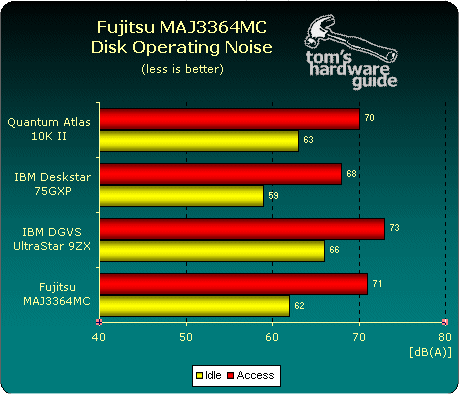A Look At SCSI-Performance: Fujitsu MAJ3364MC U160-SCSI
Disk Operating Noise
Thanks to the relatively slow rotation speed, the DeskStar 75GXP IDE drive is the least noisy model - both in access and idle mode. The idle noise of IBM's UltraStar 9 ZX is far too high to use such a drive in a desktop PC. Even if you have a solid computer case, you will always hear the high frequency whirring of this first generation 10,000 rpm drive. The new Quantum Atlas 10K II and the Fujitsu MAJ3364MC have become much better in this aspect. Still the access noise is cracking and surely bothering, but the idle noise was considerably reduced.
Conclusion
It is a strange feeling to see our former high-performance reference drive scoring almost pathetic results. Going through our numbers clearly shows that the extent of technical advance and improvement in the storage sector is at least as huge as with microprocessors.
The performance of high-end drives doubles almost every two years. That's of course not valid for the access time, but data transfer rates increase considerably with every new drive generation.
The least expensive drive of this test is no loser at all. If you are looking for a system drive with a good price/performance ratio, any high-end IDE drive similar to the IBM DTLA series will provide excellent performance which is not far away from three or four times higher priced SCSI monsters.
Yet we should not forget that most SCSI drives are optimized for multitasking applications. Simultaneous or uninterrupted data access is the big strength of SCSI drives. Usually, the CPU load during drive accesses is less as well. Unfortunately, the SCSI controller will add some extra costs to the price of the already expensive SCSI drive.
Get Tom's Hardware's best news and in-depth reviews, straight to your inbox.

Patrick Schmid was the editor-in-chief for Tom's Hardware from 2005 to 2006. He wrote numerous articles on a wide range of hardware topics, including storage, CPUs, and system builds.
-
dltaylor I owned one of these things back in the day! And let me tell you, listening to that spin up made you feel like you were starting a small jet. And yes, the clicking got old pretty quick if you're used to quietness.Reply
